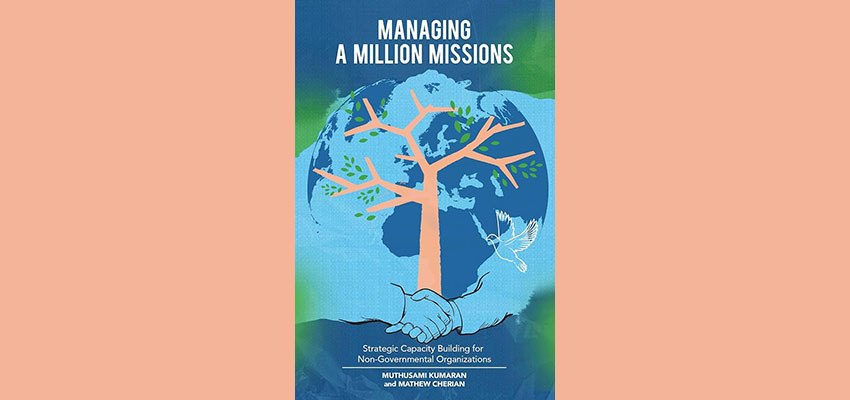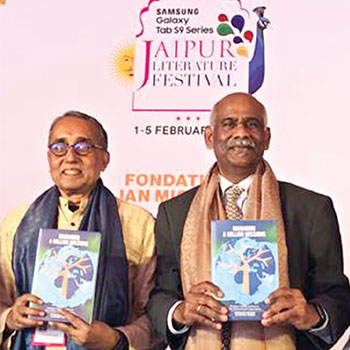A million missions made simple

If NGOs are the helping arms of a society and a country, it’s time they were strengthened through correct conceptualisation, strategy, and systems. "Managing a million missions" by Muthusami Kumaran and Mathew Cherian, is a book that addresses the primary issues that any NGO leader needs to link effective management with mission to achieve results. What makes the work ring true is that between the two of them, both Kumaran and Mathew have over 60 years of experience and expertise in NGO management across multiple countries
They are the conscience of a country; the helpers of the last resort—those who go above and beyond the outreach of governments and corporate bodies. Reminders that life is more than profit and self-interest.
By their very nature NGOs build the capacities of people they serve and improve their standards of living. They address a million issues, ranging from social to environmental. Be it helping in natural calamities like earthquakes and floods to man-made disasters like fires, war and terrorism or social questions such as violence against women and children, the education and nourishment of orphans and more. While their location, size, organisational forms, scope, and impacts can vary widely, all of them operate with a common set of creative management skills.
But the issue is, while they are launched by individuals who care about equity, justice and fair play, many NGOs lack good governance practices and specialised organisational skills required for optimum levels of effectiveness and organisational efficiency. Further, they often have difficult relationships with government agencies that provide similar public services—made worse by the lack of trust between them. At times, they fail to adhere to the laws, often due to ignorance than intent. Unfortunately, ignorance of the rules is no defence when a good, impactful and hardworking NGO is asked to shut shop.
Despite their importance and increasing roles, NGOs often lack efficient administrative, financial, and operational management skills, mainly because they are either primarily volunteer organisations or organisations whose leaders are not trained in these vital management skills. Many of these organisations are weak when it comes to organisational management, resource mobilisation and long-term sustainability, and need management skills to improve their service delivery and accountability.
During the world-wide Covid-19 crisis, the NGO sector world-wide stepped up to the plate and provided food, medicines, aid, and other humanitarian help wherever needed. But after that, it’s been in retreat due to withdrawal of funders and stricter regulations and shutdown of CSR programmes.

So, the question facing the NGO sector is other than health, is it really withdrawing from other sectors. The NGO head honchos who lived through the change realise it’s time to change and adapt.
The book "Managing a million missions" is a step in that direction. So, whether you are a mid-career NGO or one looking to set up store, this book is worth a read.
ABOUT THE AUTHORS
Muthusami Kumaran is the Associate Professor of Nonprofit Management and Community Organisations, Department of Family, Youth and Community Sciences, University of Florida, USA. He teaches various applied courses in nonprofit management and conducts research in the NGO sector. Mathew Cherian has served as the Chief Executive of Help Age India, based in New Delhi for 18 years and currently serves on several nonprofit boards, committees, and advisory positions.
"The book brings home the basic point that running an NGO is as strategic and well-thought out mission, as running a corporate outfit. Both wish to succeed, and it is important that they do with professionalism and commitment"
The Review
This seemingly imposing book, Managing a million missions, is actually lucid and simple to read. Complex information and jargon are broken into digestible bits.
The work is organised into six sections and nineteen chapters, of which fourteen deal with specific management topics important for efficiency and impact. The section-I of the book is about the scope and role of the NGO sector, strong foundational concepts, and the rules they need to adhere to. It helps to have context and background on terms that are second nature to NGOs, for instance, “advocacy”.
In Section-II the strategic capacity building framework for NGOs is elaborated, along with the key elements of good governance, transparency, and accountability. Section-III focuses on planning, implementing, monitoring, and measuring client-centric programmes.
Interestingly, Section-IV deals with the management of various human resources that are essential for successful NGO operations and impacts. Section-V is about resource mobilisation-fundraisers and networking included. It stresses the importance of a systematic fundraising plan with diversified sources of funds. If an NGO depends on simply one or two sources for 75 per cent of its funds, it’s on risky turf; sadly, that means most NGOs fall into that zone. And so, to thrive NGOs need to bring in more revenues than their expenditures on an annual-cyclical and continuous basis. A financial control system is spelt out as well—and it’s different for different types of NGOs. Plus, did you know, there’s a difference between different kinds of volunteer work—direct and indirect? It's details such as these that make the book value for effort and time.
Last but not the least, Section-VI walks the reader through risk management, legal and ethical aspects, and future directions of NGO capacity building. This is critical because knowing the law is the difference between failure and success of the organisation. To quote Mahatma Gandhi: “There is enough for everybody’s need but not their greed.” While helping the disenfranchised and the marginalised is a core value, there is a growing concern that there are an increasing number of entrants without a moral compass or ideology.
The all-important accountability standards and codes of conduct that builds trust within and outside the organisation, help have a dialogue with the local community
It’s clear the writers are walking the talk, for the work also includes the need for marketing the cause and getting out of their “cocoon” and networking. Social auditing is another new approach that has evolved in evaluating NGO work with various stakeholders—both individuals and groups affected by the activities under review. To that end, an elaborate checklist has been included that addresses such detailed questions as the correctness of the NGO’s communication plan, the familiarity of your organisation with social media, the presence or absence of a vibrant website with text and audio-visual content, the scale of outreach with stakeholders etc.
Each topic is discussed threadbare, and the book brings home the basic point that running an NGO is as strategic and well-thought out mission, as running a corporate outfit. Both wish to succeed, and it is important that they do with professionalism and commitment.